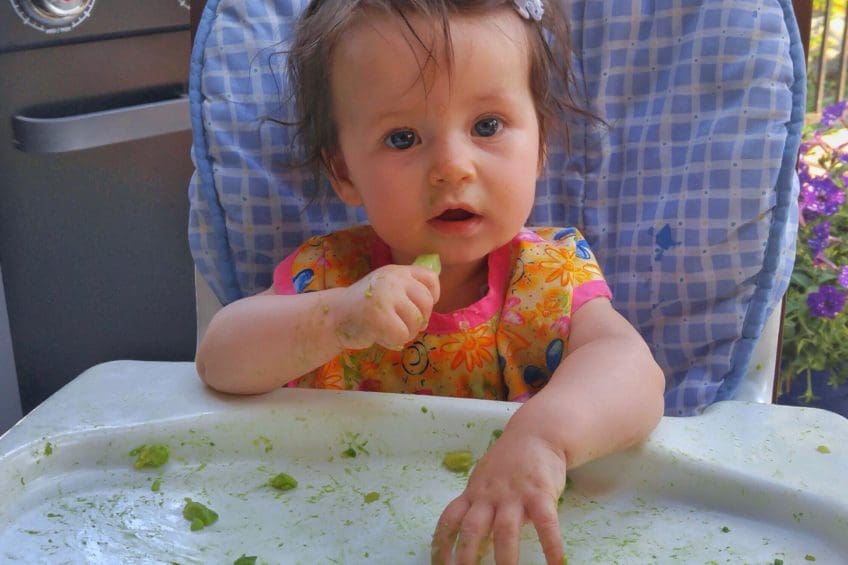Your Baby’s First Foods: Which Method and When
Your Baby’s First Foods is a three-part series of blogs on how to introduce solid food to your baby. The first part, ‘Your Baby’s First Foods: Which Method and When’, will introduce you to the common methods, when to start and which foods to start with. The second part, ‘Your Baby’s First Foods: How and How Often’ will give instructions on how to begin the process and the third part, ‘Your Baby’s First Foods: Tips for Success’, will give a few suggestions and tricks to make the process as smooth as possible.
As first-time parents, it can be both scary and exciting to introduce solids to your baby. It is common to be a little nervous, but remember: the more nervous you are the more nervous your child will be! The two most common methods for introducing foods are purees or baby led weaning. You can also try some combination of the two. However, the method you choose depends on both you as a parent and your child.
What Method is Best?
The truth is the best method is the one that works for you and your child. Once the gag reflex is fully developed most babies are ready for a wide variety of texture (purees to soft finger foods). It depends on what you as parents are comfortable with, and what the child’s preference is.
Regardless of which texture you start with, it’s important to let your child lead. Whether self-feeding or using a spoon, always feed to an open and ready mouth and allowing the child to eat as much or as little as they would like. Your child will let you know when they have had enough by not eating any more, closing their mouth, swatting at the spoon, turning their head, or crying. Children will eat until they are full and then will stop. By respecting their instincts you are helping them to understand their body’s hunger and satiety, and giving them the skills to avoid overeating now and down the road.
Pureed foods
Traditionally you start with pureed foods at six to seven months, then well mashed foods from seven to eight months, and soft cooked finger foods at nine plus months. Finger foods would include bananas, soft-cooked vegetables, broccoli, green beans, carrots, strips of toast etc. Once you are comfortable you should offer a variety of textures each day.
You should also try to make your own puree, and not use jars/squeeze pouches as they often have added seasonings such as sugar or salt. It is important for children to know that they are eating broccoli or rice. When it comes from a jar or pouch it may confuse them and they may develop a habit of seeking prepackaged food.
Baby-led Weaning
Start by offering soft-cooked age-appropriate foods that are in finger-like shapes that are easy for your child to hold so they can feed themselves. It is important that you allow the child to feed themselves and the food should be the same food that the family is eating.
Combination of the Two Methods
This is where you offer foods on a spoon if they make sense (apple sauce, yogurt, hot infant cereal), and offer soft finger foods, to encourage self-feeding, grabbing, chewing, pacing of eating, and choosing how much they eat. You can also give your child a spoon and put the food on it for them to try to feed themselves.
Choking hazards: Avoid offering small, hard, round foods, or sticky foods such as hard candies, cough drops, gum, whole grapes, popcorn, marshmallows, nuts, or fish with bones until your child is at least four years old. Make sure that grapes/sausages/hotdogs are cut in half, stringy foods such as pineapple or celery are finely chopped, hard vegetables (e.g. carrots) steamed, pits are removed from fruits, and nut butters are thinly spread.
When to Start?
The recently updated Canadian infant feeding guideline’s current recommendation is to introduce real foods at around six months of age (prior to this the babies diet should consist of 100% breastmilk and/or formula). From six to eight months most the child’s nutrition (80%) will continue to be from breastmilk and/or formula, with 20% from food. From nine to twelve months this shifts to 50% each, moving to more food less breastmilk and/or formula after one year.
Signs of Readiness
Around the six month mark start watching for readiness cues to identify the best time to introduce solids:
- Your child has at least doubled his or her birth weight and weighs at least 13 pounds
- Your chid can hold their head up on their own, with good head control (be able to sit in a high chair or feeding chair)
- Opens mouth when food comes their way: you want to feed a child with an open and waiting mouth as opposed to forcing it in
Why You Shouldn’t Start Too Early or Too Late
If your pediatrician recommends starting before 6 months consider starting with purees because most children have not fully developed their gag reflex at this point, putting them at an increased risk of choking. Research also suggests that the digestive tract is not fully developed and may not be able to digest the nutrients in real food yet. On the other hand, unless recommended by the baby’s pediatrician, starting later may put your child at risk for iron deficiency and/or make the transition to real food more challenging and potentially create issues with picky eating.
Which Foods First?
Start with iron-rich foods because your baby’s iron needs increase around this time; their maternal stores are running out and their needs are beyond what breastmilk and formula can offer. These foods can include:
- Soft/tender pieces of cooked meat/poultry finely minced, ground or mashed
- De-boned fish
- Well-cooked whole eggs (boiled, scrambled, over hard etc.)
- Beans and lentils
- Iron-fortified single-grain cereal thinned out with breastmilk or formula (look for one with no added sugar or salt)
Once you have introduced some iron-rich sources consider introducing some vegetables and fruits as they are a great source of vitamin C which helps to increase iron absorption. From this point you can start introducing whole grain foods, natural nut and seed butters and pasteurized dairy products (high fat yogurt and cheese).
Homogenized cow’s milk can be introduced between nine and twelve months, but it is not in place of breastmilk or formula until one year of age.
Research shows that common allergens such as eggs, nut butters and fish, can be introduced as early as six months. Early exposure to common allergens may prevent allergies from developing. Even in children who are at an elevated risk of developing a food allergy.
Stay tuned for ‘Your Baby’s First Foods: How and How Often’ coming in July 2017!

